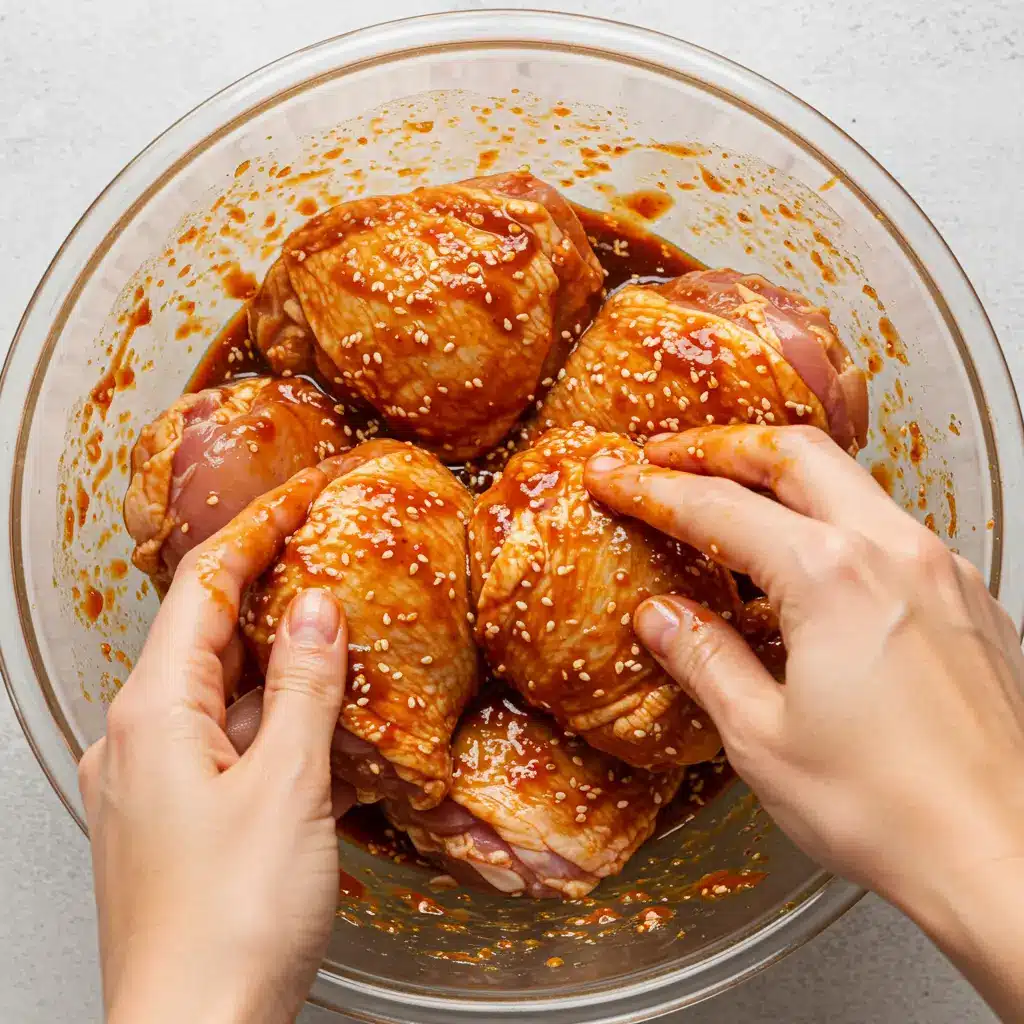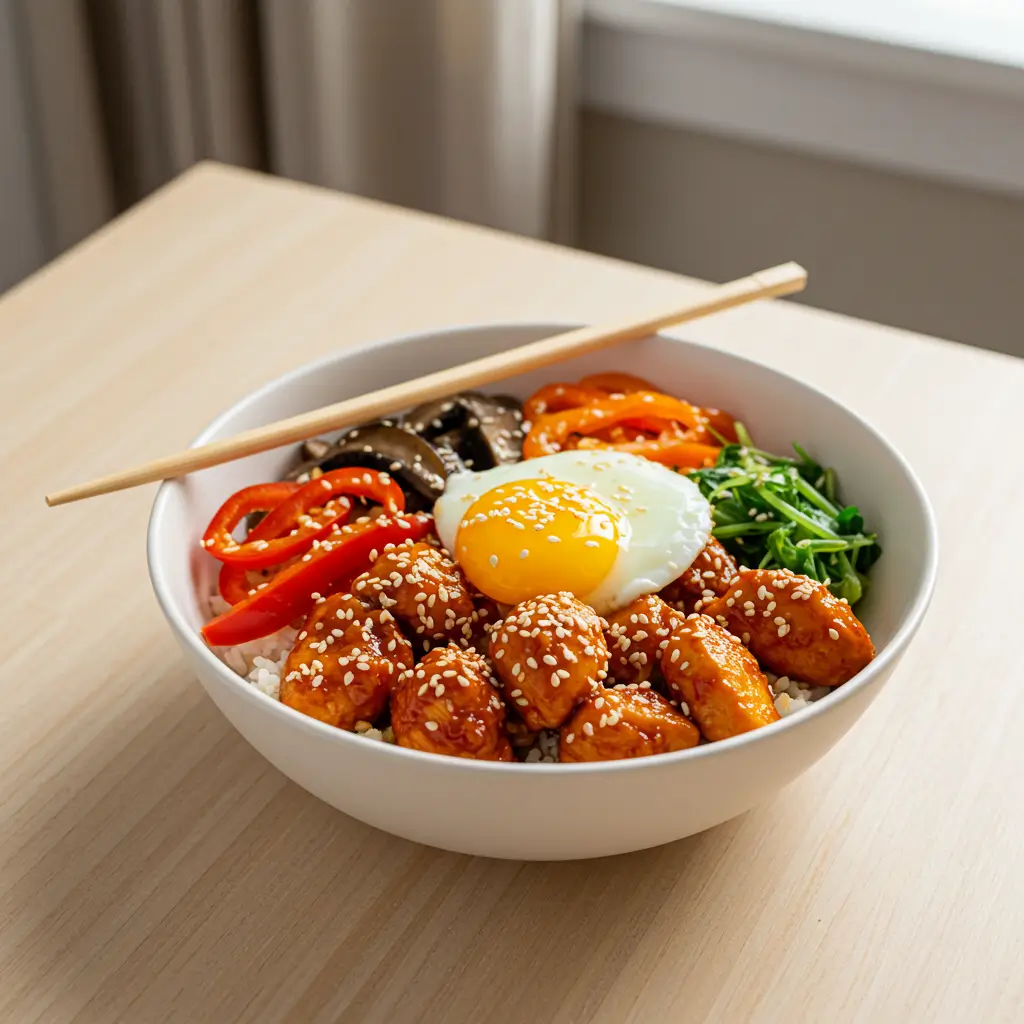Gochujang Chicken Bowls aren’t just another trendy meal prep idea—they’re a bold blend of heat, sweetness, and umami wrapped in comfort. For me, these bowls represent a harmony between my Japanese heritage and the fiery punch of Korean flavors. They’re quick to assemble, easy to customize, and deeply satisfying.
It all started back in our little seafood shack on the Monterey pier. My father’s grilled mackerel and soy-marinated clams were the kind of meals that warmed fishermen after a long haul. One day, I brushed gochujang glaze onto some chicken thighs and tossed them on the grill. The smell alone brought people in. That first version was rough, but it sparked something.
Since then, these bowls evolved into something special. In this guide, I’ll show you how to build the perfect Gochujang Chicken Bowl from the marinade to the toppings—plus how to pair it with craveable sides like this quick cucumber salad or bacon parmesan pickle chips. Whether you’re new to gochujang or just looking for a punchier alternative to your usual street corn chicken bowl, this is a dish that delivers bold comfort every time.
Table of Contents
Table of Contents
Why Gochujang Chicken Bowls Hit Every Note
The secret behind gochujang flavor layering
The bold, balanced flavor of Gochujang Chicken Bowls comes from more than just spice. Gochujang, Korea’s iconic fermented chili paste, builds warmth that lingers without overpowering. When I combine it with sesame oil, soy sauce, garlic, and brown sugar, the result is a deeply savory glaze that hugs every bite of chicken and caramelizes beautifully.
Just like in our street corn chicken bowls, flavor contrast is essential. The heat needs a counterpoint—cool, crisp elements like pickled radish, cucumbers, or slaw. It’s this interplay that makes Gochujang Chicken Bowls so addictive. Top it with a jammy egg or toasted sesame seeds for that final textural snap.
For extra crunch, I’ve also added components like fried shallots or crispy toppings inspired by our bacon parmesan pickle chips. These little details elevate a good bowl into something unforgettable.
Choosing your base: rice, grains, or greens
White rice is the classic base for Gochujang Chicken Bowls. The neutral flavor softens the spice and holds up well to saucy proteins. But I’ve also served this dish over farro, jasmine rice, and even cauliflower rice with excellent results.
For a lighter variation, try swapping grains for a bed of greens. Tossed arugula or baby spinach adds freshness and turns the dish into a protein-packed salad—similar to the balance found in our jalapeño popper chicken salad. Whichever way you build it, Gochujang Chicken Bowls always bring comfort with a kick.
Preparing and Cooking Gochujang Chicken Bowls
Marinating for maximum flavor
To get the most out of your Gochujang Chicken Bowls, start with a bold, balanced marinade. Here’s what I use:

- 3 tablespoons gochujang
- 1 tablespoon soy sauce
- 1 tablespoon toasted sesame oil
- 1 tablespoon rice vinegar
- 1 tablespoon brown sugar
- 2 cloves garlic, grated
- 1 teaspoon fresh ginger, minced
- Optional: ½ teaspoon gochugaru (Korean red pepper flakes) for extra heat
Mix everything in a bowl until smooth. Then, add 1–1.5 pounds of boneless, skinless chicken thighs. Toss to coat evenly. Cover and refrigerate for at least 30 minutes (ideally 2–4 hours). The result is chicken that’s deeply seasoned, not just surface-flavored.
If you’re short on time, even a quick 20-minute soak works thanks to gochujang’s intensity. That said, a longer marinade will infuse the chicken with richer depth, much like the flavor layering you’ll find in our boursin tomato pasta with salmon, where every bite carries the sauce into the center.
Searing or grilling for caramelization
Once marinated, it’s time to cook. I recommend two methods: pan-searing or grilling.
Pan-searing in a cast-iron skillet gives you crisp edges and a caramelized exterior. Heat the pan with a splash of oil, then lay in the chicken without crowding. Cook over medium-high heat until it browns and naturally releases from the pan, about 4–5 minutes per side.

Grilling is fantastic too, especially over charcoal. The smoky char adds complexity that balances the fermented heat. Either method works beautifully, depending on your kitchen and preferences.
Once cooked, let the chicken rest for 5 minutes, then slice it thinly. Serve it immediately over your chosen base—rice, farro, or greens—then layer on fresh toppings.
For texture contrast, I love serving these bowls with a crisp side dish like our bacon parmesan pickle chips or a cooling yogurt drizzle if the heat creeps up.
Meal Prep & Storage for Gochujang Chicken Bowls
Make-ahead tips for busy weeks
One of the biggest reasons I love Gochujang Chicken Bowls—aside from their bold flavor—is how well they work for meal prep. The chicken actually gets better after a night in the fridge. The marinade deepens, and the glaze becomes even more satisfying once reheated.
If you’re prepping for the week, cook a big batch of chicken, then portion it with rice and toppings into meal containers. Keep raw elements like shredded cabbage, scallions, or herbs separate so they stay fresh. This setup works beautifully for a 4–5 day lunch rotation.
Another tip? Double the marinade and store half as a drizzle or dipping sauce. You can even repurpose it in dishes like our jalapeño popper chicken salad for a fiery dressing variation.
How to reheat without drying out
No one wants dry chicken, especially in a dish built on rich, sticky glaze. When reheating Gochujang Chicken Bowls, splash a bit of water or broth over the rice and chicken before microwaving. Cover with a lid or damp paper towel and heat in 30-second intervals until just warm.

If you have time, toss the chicken back into a hot skillet for a few minutes to bring back that original caramelized edge. It makes a big difference in flavor and texture.
And don’t forget the toppings. Add fresh veggies or a drizzle of spicy mayo after reheating to bring the bowl back to life. Just like our boursin tomato pasta with salmon, the details matter—especially when leftovers are in play.
For quick sides, consider pairing your bowl with bacon parmesan pickle chips or roasted edamame. They’re easy, snackable, and add texture your bowl will thank you for.
Frequently Asked Questions
What is gochujang and how spicy is it?
Gochujang is a Korean fermented chili paste made from red chili powder, glutinous rice, fermented soybeans, and salt. Its flavor is deep, rich, and slightly sweet, with a heat that builds slowly rather than hitting all at once. On its own, it can feel medium-spicy to some. But when blended with other ingredients—as in these Gochujang Chicken Bowls—the heat softens and becomes more balanced.
Can I make gochujang chicken bowls ahead of time?
Yes, Gochujang Chicken Bowls are excellent for meal prep. The chicken can be marinated up to 24 hours in advance and cooked in batches. You can portion out the chicken, rice, and toppings into containers for easy grab-and-go meals. Keep raw vegetables and sauces separate to preserve texture and freshness.
What vegetables go well in gochujang chicken bowls?
Crisp, fresh vegetables offer the perfect contrast to spicy gochujang-glazed chicken. Great options include shredded cabbage, sliced cucumbers, carrots, radishes, scallions, and baby spinach. Pickled vegetables also work well. These add crunch, color, and cooling elements that balance out the rich, spicy base of the bowl.
Are gochujang chicken bowls healthy for meal prep?
Gochujang Chicken Bowls can be a nutritious meal prep option. They’re protein-rich and easy to customize based on your dietary needs. Use brown rice or cauliflower rice for added fiber or lower carbs, and load up on vegetables for vitamins and crunch. You control the portions and ingredients, making it healthier than takeout alternatives.
Conclusion
If you’re craving bold flavor that satisfies and comforts all at once, Gochujang Chicken Bowls deliver every time. They’re fast to prep, endlessly customizable, and layered with spicy, savory, and tangy elements that just work. From busy weeknights to meal-prepped lunches, these bowls never disappoint.
Whether you’re searing chicken in a skillet or grilling outside, that gochujang glaze brings restaurant-level flavor to your home kitchen. Add rice or greens, pile on crisp veggies, and you’ve got a meal that feels both fresh and indulgent. And if you’re like me, you’ll want to keep a jar of that marinade ready in your fridge at all times.
Inspired to keep experimenting? Explore other bold builds like our street corn chicken bowls or the deeply satisfying boursin tomato pasta with salmon. Stay curious—because the best bowls are always the ones you make your own.
PrintGochujang Chicken Bowls: Bold, Spicy, and Easy to Make
Bold, spicy, and comforting, these Gochujang Chicken Bowls feature juicy marinated chicken, fresh vegetables, and sticky rice—perfect for meal prep or weeknight dinners.
- Prep Time: 10 minutes
- Cook Time: 15 minutes
- Total Time: 25 minutes
- Yield: 4 servings 1x
- Category: Main Dish
- Method: Stovetop
- Cuisine: Korean Fusion
Ingredients
1.5 lbs boneless skinless chicken thighs
3 tbsp gochujang (Korean chili paste)
1 tbsp soy sauce
1 tbsp toasted sesame oil
1 tbsp rice vinegar
1 tbsp brown sugar
2 cloves garlic, grated
1 tsp fresh ginger, minced
1/2 tsp gochugaru (optional)
2 cups cooked white rice or grain of choice
1/2 cup pickled cucumbers or radish
1/2 cup shredded carrots
1/2 cup sliced scallions
2 soft-boiled or fried eggs
1 tbsp toasted sesame seeds
Instructions
1. In a bowl, mix gochujang, soy sauce, sesame oil, vinegar, sugar, garlic, ginger, and gochugaru.
2. Add chicken thighs and coat evenly. Marinate for at least 30 minutes (up to 4 hours).
3. Heat a skillet over medium-high heat with a little oil.
4. Sear chicken for 4–5 minutes per side until caramelized and fully cooked.
5. Let chicken rest for 5 minutes, then slice.
6. Assemble bowls with rice, sliced chicken, and toppings like carrots, scallions, cucumbers, egg, and sesame seeds.
7. Optional: drizzle extra sauce or spicy mayo over top before serving.
Notes
You can substitute chicken with tofu for a vegetarian version.
Store cooked chicken and rice separately from fresh toppings for best meal prep results.
Adjust spice by using less gochujang or adding honey for sweetness.
Nutrition
- Serving Size: 1 bowl
- Calories: 480
- Sugar: 7g
- Sodium: 720mg
- Fat: 20g
- Saturated Fat: 4g
- Unsaturated Fat: 14g
- Trans Fat: 0g
- Carbohydrates: 42g
- Fiber: 3g
- Protein: 32g
- Cholesterol: 145mg
Let’s Stay Connected: Love recipes like these Street Corn Chicken Bowls? Follow us on Pinterest for daily inspiration, catch full video walkthroughs on YouTube, and join the flavor-loving community on Facebook. For more delicious meals, visit MyFamilyPlates and browse all our recipes.





